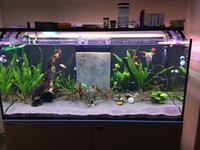Hi all,
Ok need some advise and help.
Over the past 6 months i have slowly upgrade my kit from a DIY CO2 system with a normal diffuser stone to a pressure system with a inline diffuser 2 months ago.
I have a Red Sea 350 tank and sump, with K1 media for the bio filter.
Over the past couple of week i have been uping my CO2 input from 1/2 bps to about 8 bps in an attempt to hit the right CO2 level for the plants. I think im about there but now my tank now looks like a fizzy drink.
Two questions really.
1) by running air powered K1 media, am i just removing the CO2 im pumping in. And
2) can i run a second inline CO2 diffuser to help desolve to CO2 before getting to the tank.
Ok need some advise and help.
Over the past 6 months i have slowly upgrade my kit from a DIY CO2 system with a normal diffuser stone to a pressure system with a inline diffuser 2 months ago.
I have a Red Sea 350 tank and sump, with K1 media for the bio filter.
Over the past couple of week i have been uping my CO2 input from 1/2 bps to about 8 bps in an attempt to hit the right CO2 level for the plants. I think im about there but now my tank now looks like a fizzy drink.
Two questions really.
1) by running air powered K1 media, am i just removing the CO2 im pumping in. And
2) can i run a second inline CO2 diffuser to help desolve to CO2 before getting to the tank.



